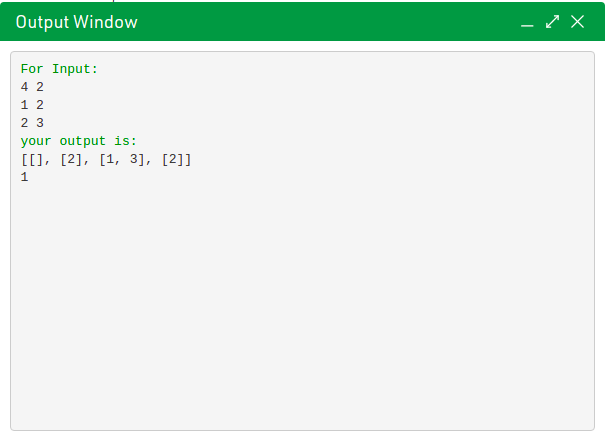this problem is to detect a loop in an undirected graph
problem link :- Detect cycle in an undirected graph | Practice | GeeksforGeeks
my code —>
```
bool cycle(vector<int> adj[], int s, bool visited[], int parent)
{
visited[s] = true;
for(auto x:adj[s])
{
if(visited[x] == false)
if(cycle(adj,x,visited,s)==true)
return true;
else if(x!=parent)
return true;
}
return false;
}
bool isCycle(int V, vector<int>adj[]){
bool visited[V];
for(int i=0;i<V;i++)
visited[i] = false;
for(int i=0;i<V;i++)
{
if(visited[i] == false)
if(cycle(adj,i,visited,-1) == true);
return true;
}
}
I am getting a wrong answer
Input:
Its Correct output is:
And Your Code’s output is:
If an adjacent vertex is visited and is not parent of current vertex, then there exists a cycle in the graph.
if(cycle(adj,i,visited,-1) == true);
Please remove ; from the end of this line, otherwise, your function will always return true irrespective of if condition
Lol, I tried printing the Adjacency list and this happened.
If you don’t understand what it is, here is the explanation.
What we think the graph is:
0 → null
What actually the graph is:
0 → null
As you can see, there is a cycle. I guess it’s the fault of code stubs. The edges are bi-directional.
Oh, I have mistaken, it’s Undirected graph. So, I should change my approach.
actually, that didn’t help either
1 Like
Is your code for Directional graph or undirectional graph?
it’s for undirected graph
I am unable to find the bug
1 Like
Hey! Put the first if statement in braces.
if(visited[x] == false){
if(cycle(adj,x,visited,s)==true)
return true;
}
no bro, since they are indented properly, i think it’s one and the same thing
still not working for me bro
bool cycle(vector<int> adj[], int s, bool visited[], int parent){
visited[s] = true;
for(auto& x:adj[s])
{
if(visited[x] == false){
if(cycle(adj,x,visited,s)==true)
return true;
}
else if(x!=parent){
return true;
}
}
return false;
}
public:
bool isCycle(int V, vector<int>adj[]){
// Code here
bool visited[V];
for(int i=0;i<V;i++)
visited[i] = false;
for(int i=0;i<V;i++)
{
if(visited[i] == false)
if(cycle(adj,i,visited,-1) == true) return true;
}
return false;
}
};
Does this work?
YES YES that worked… thanks
why did the indented nested “for” loop didn’t work well ? Usually I don’t give brackets if it has a single line inside it and it works well.
divij_gera:
return false;
return false line at the end also made the difference
So I am not sure but what happens is that the else statement belongs to the innermost if. Now since you weren’t enclosing the outermost if in brackets the else statement was being used when the inner if failed. For that reason, I didn’t put the nested if-statement of the isCycle function in braces since it had no else to work with
" The Java programming language, like C and C++ and many programming languages before them, arbitrarily decrees that an else clause belongs to the innermost if to which it might possibly belong."Chapter 14. Blocks and Statements
1 Like
ohh thanks a lot, I didn’t know this before…
2 Likes




 oh no
oh no